CRITTERS

It was a summer like no other in our memory. No ball games with the “CRACK!” of the bat hitting the ball and the raucous cheers of the fans. No blockbusters and salty popcorn at the empty theater. No festivals, carnivals, amusement parks, pow-wows or fairs. No drum. No bass. No melody. No dancing under the brightly colored lights. No cotton candy or cracker jack. No striking up a conversation about the weather while standing in line to buy beer: “Hot enough for you?” No brushing past one another while strolling down the boardwalk, dodging the tram car with its loud robotic voice repeating: “Watch the tram car, PLEASE watch the tram car!” No smelling suntan oil in a hug and tasting salt water in a kiss.
Here on the East Coast of the U.S., it was as if all the familiar sights, sounds, smells, and tastes of summer had suddenly abandoned us. Only the humidity remained, like a lazy dog lying all stretched out and sleepy-heavy on top of us, breathing in our faces. “Get up, you big old dog!” we said to the air, “You’re smothering us. We can’t breathe.” But the dog wouldn’t budge. Wearing masks kept us safe but exacerbated our respiratory problems. “Oh well,” we said, “we’re just going to have to learn to live without breathing.”
And then, into our oppressively humid sensory deprivation tankof a life, came the critters.
First came the giant frog we named Kermit.[1] We were gardening at night to avoid getting scorched by the sun, and he came leaping out of the darkness from 4 feet away, right into the hole we had just dug. “Hey, you gotta get out of there, dude” we said, “that’s for a tomato plant, not a frog.” He got out of that hole but then he jumped into another hole we dug on the other side of the yard. “Hey, you better be careful or you’ll get buried!” Then it dawned on us that maybe Kermit wanted to get buried; animals repeat certain behaviors for biological reasons, unlike people who are creatures of habit. Curious, we did some research and learned that, to survive winter, most frog and toad species burrow down into the soil beneath the frost line and the high glucose concentration in their vital organs acts like antifreeze while they hibernate.[2] We also noticed Kermit sitting right up next to our lantern, staring trance-like into the light, so mesmerized that we were able to get this close up.
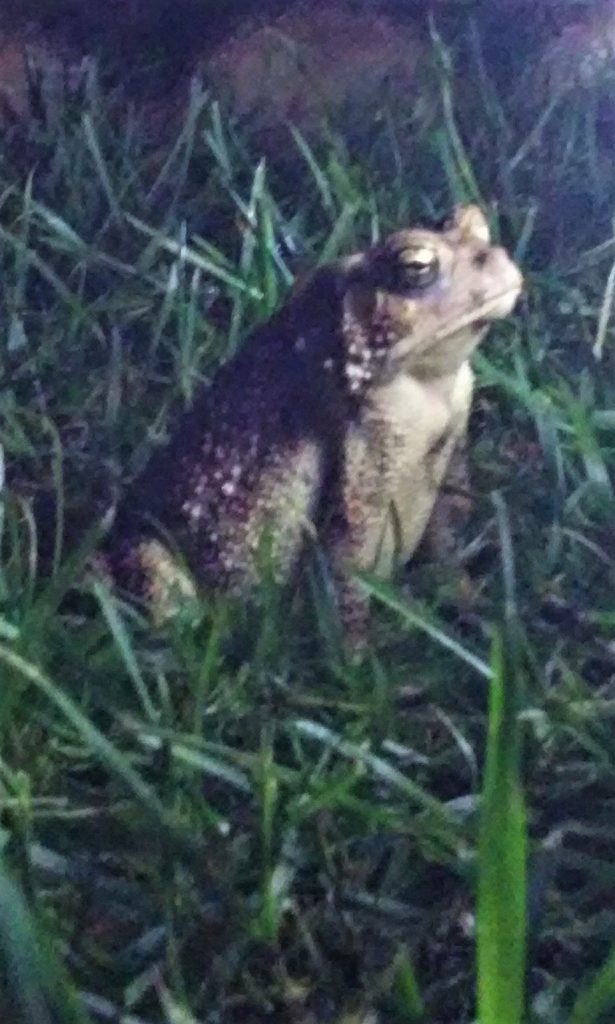
We discovered that frogs and toads are attracted to light because light attracts yummy insects.[3] A few nights later, our lantern enticed a frog we thought was Kermit until we realized he was smaller and not nearly as fun. He just pooped on our patio and hopped away. Total bummer. The Cope’s Gray Treefrog (Hyla chrysoscelis) clinging to our sliding glass door made up for it, though. Knowing that the light coming from indoors will deliver “fast food,” it was amusing to watch this hungry guy snarf up bugs like a teenage boy devouring a pizza.
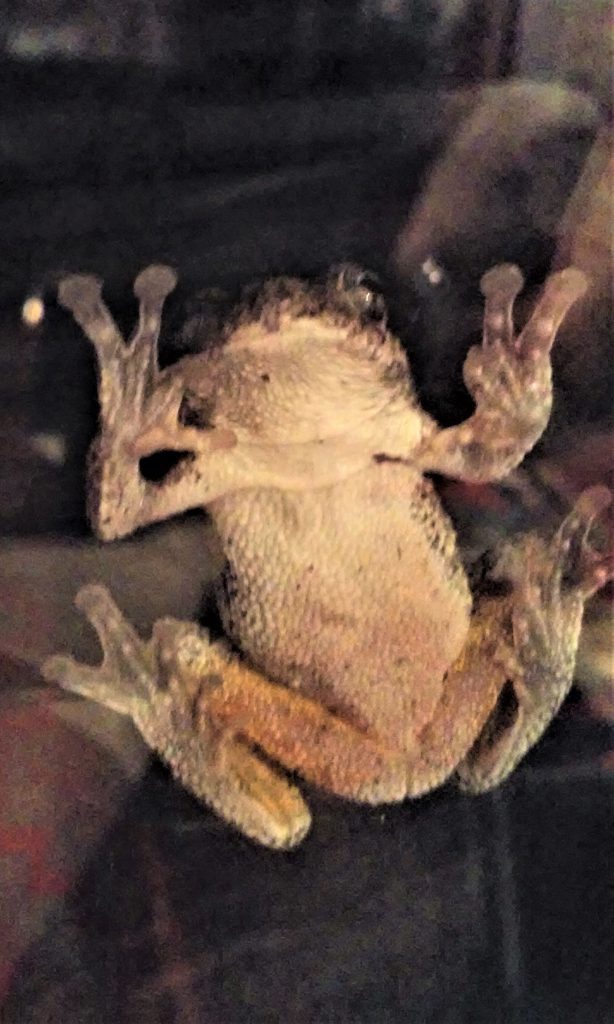
One day, while walking to the mailbox, we saw a gorgeous Tiger Swallowtail (Papilio glaucus) fluttering around in our neighbor’s butterfly bush. If you want to bring these beauties into your yard, and you don’t have enough space for a butterfly bush, try planting black-eyed Susans, purple coneflowers (Echinachea purpurea), sweet pepperbush, or phlox, all of which are “attractive nectar sources” for Tiger Swallowtails and other pollinators.[4]
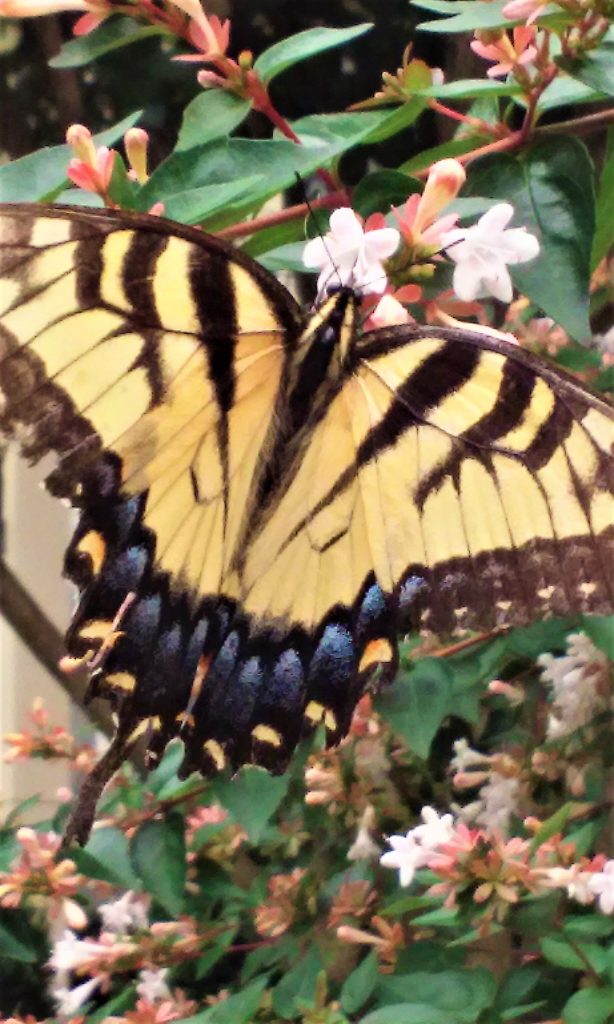
In many cultures, a butterfly landing on you is a good omen. This Common Sootywing (Pholisora catullus) might have confused the floral print on this bathing suit with actual flowers but instead of flying away disappointed when there wasn’t any nectar, she floated around the pool on our raft, just chillaxing. According to dream interpretation, close contact with a butterfly means liberation and new beginnings. According to Christian symbolism, it means resurrection and immortality. And in ancient Greek mythology, it represents Psyche, the Goddess with butterfly wings who personifies the human soul. But scientists say the butterfly just wants the salt in our sweat. Like us, they can’t live on nectar alone.[5]
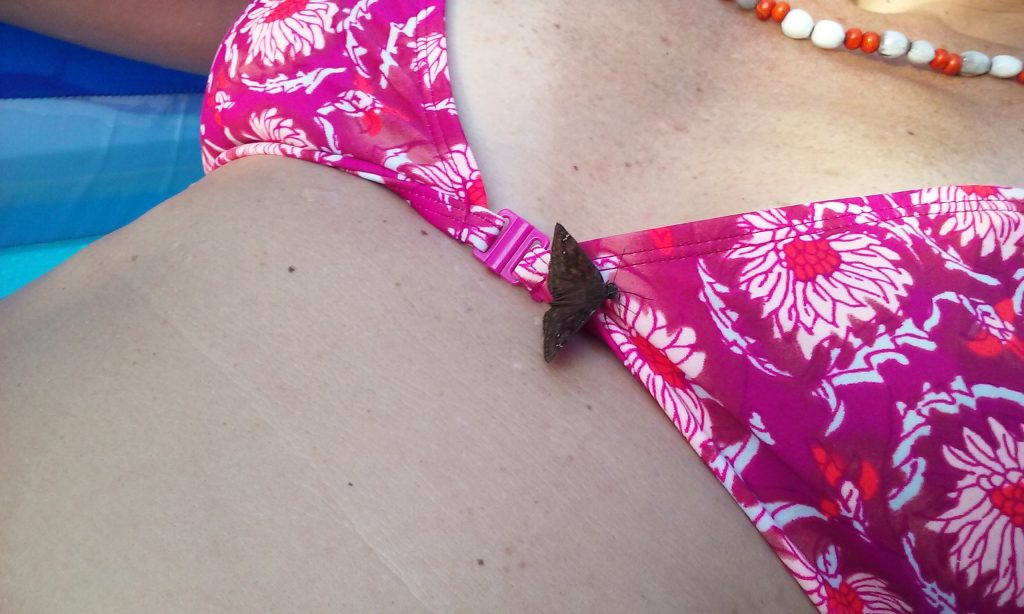
Another insect that enjoys engaging with humans is the katydid. As kids, we called them leaf bugs because their camouflage mimics the bright green color and shape of leaves and the way they move mimics the rustling of leaves. Apparently, they got their name from the mating call that the males make by rubbing their wings together that supposedly sounds like “KA-TY-DID!, “ but I think it sounds more like a cross between buzzing and rattling. Because katydids are nocturnal, you’ll know if you’ve got katydid neighbors because this sound gets louder as the night wears on just like bros get louder the more drinks they consume. Every night, by 2:00 am, the katydid frat party would make an infernal racket in the woods behind our house, but we knew the cops would have been powerless to stop them, so we didn’t bother calling.
One evening after coming inside from the back yard, we noticed this guy gingerly stepping along our shirtsleeves! You can’t tell from the picture, but he was a big boy, 3 to 4 inches long. Without making a fuss, we persuaded him to walk onto this fan made from palm fronds, seeming cooperative enough. But when we tried to get him to leave the house, oh no, he wasn’t having any of that!! He jumped off the fan, and then leapt up onto the kitchen wall. Somehow we managed to get him to go back on the fan and stuck the fan out the sliding glass door. Then, he rubbed his wings together and let out a great big “KA-TY-DID!” as if he were yelling at us for kicking him out so rudely: ”But I just got here! I didn’t even get to sample the buffet!”
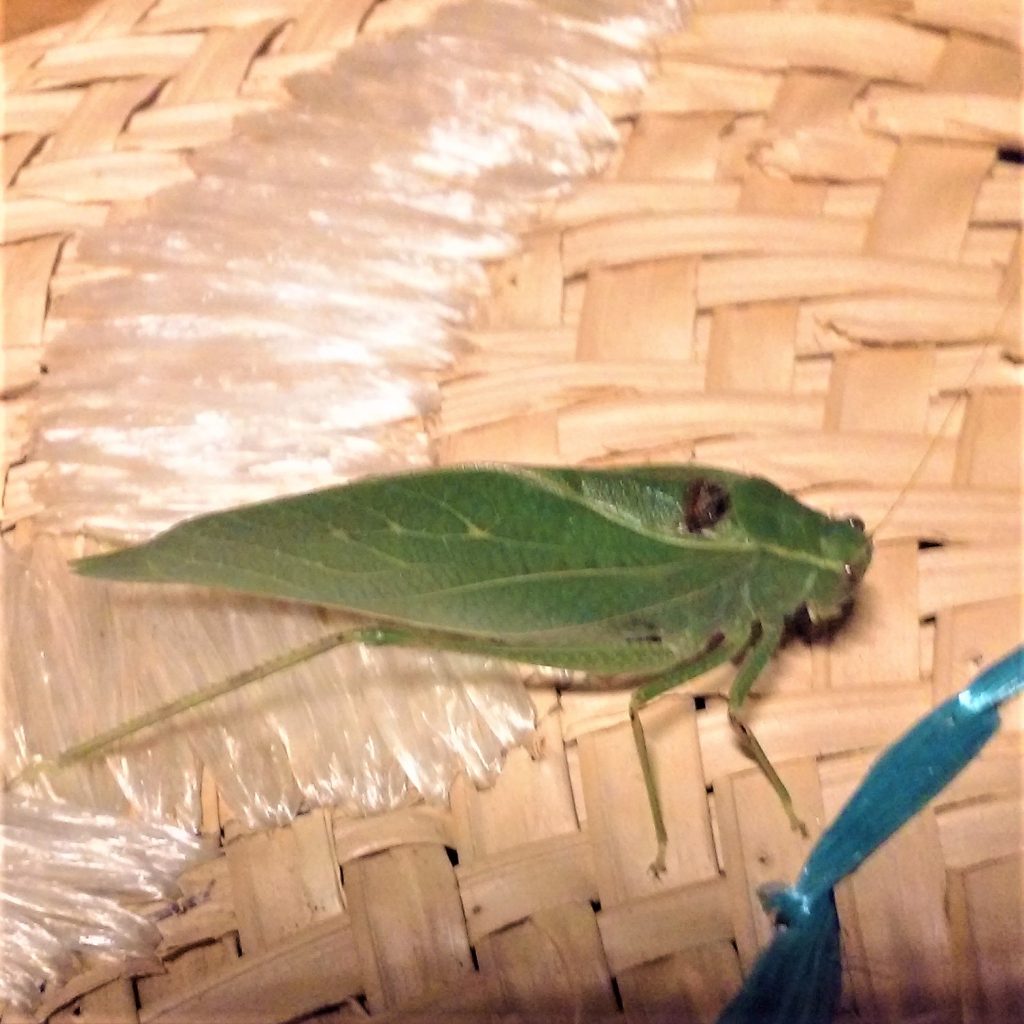
We later learned that there are over 200 species of katydidsand that our house guest is known as the Greater Angle-Winged Katydid or Broad-Winged Katydid (Microcentrum rhombifolium).[6] We’re thinking that katydids must be able to sense there’s food in our houses because it’s not uncommon for katydids to attempt to endear themselves to humans. And yes, people have been known to feed katydids and keep them as pets![7]
Unlike extroverted katydids, leaf-footed bugs are the wallflowersat the party. We had to get up super close and personal to take a picture of this prehistoric looking Leaf-footed bug (Family Coreidae) creeping around on our fern. Fortunately we didn’t scare him, because like skunks, these bugs can “emit a strong odor when threatened or handled.”[8]
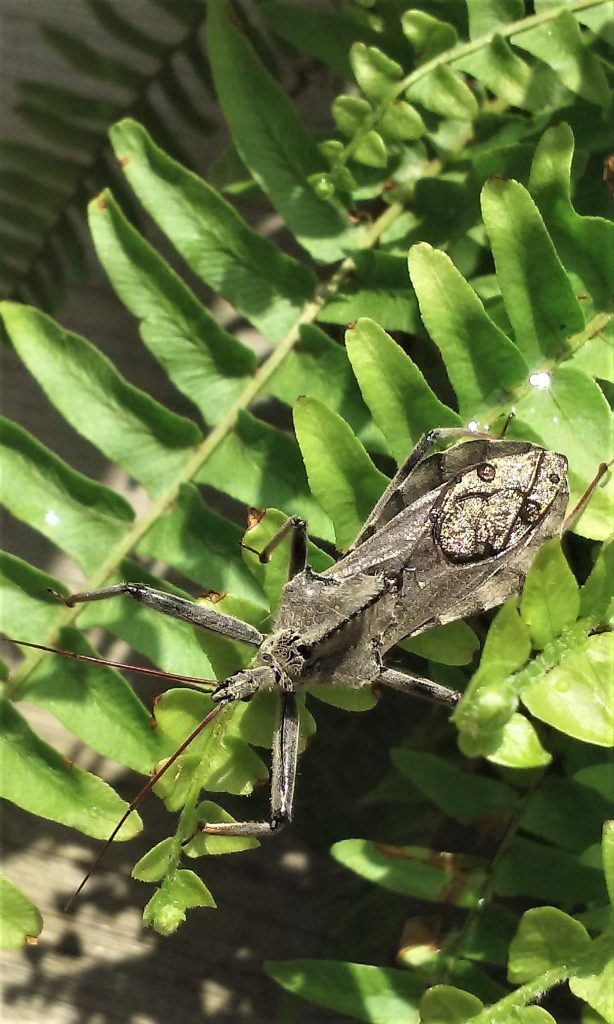
On sunny days, we would find these adorable lizards scurrying about on the patio chasing bugs. They’re called 5-lined Skinks due to the 5 white or yellow vertical lines running from nose to tail like the lines painted on the road. Only juveniles have blue tails like this little girl who blends right into our colorful rug made of recycled plastic threads. Apparently, the male clamps his mouth around his partner’s neck before mating. Kinky skinks! [9]
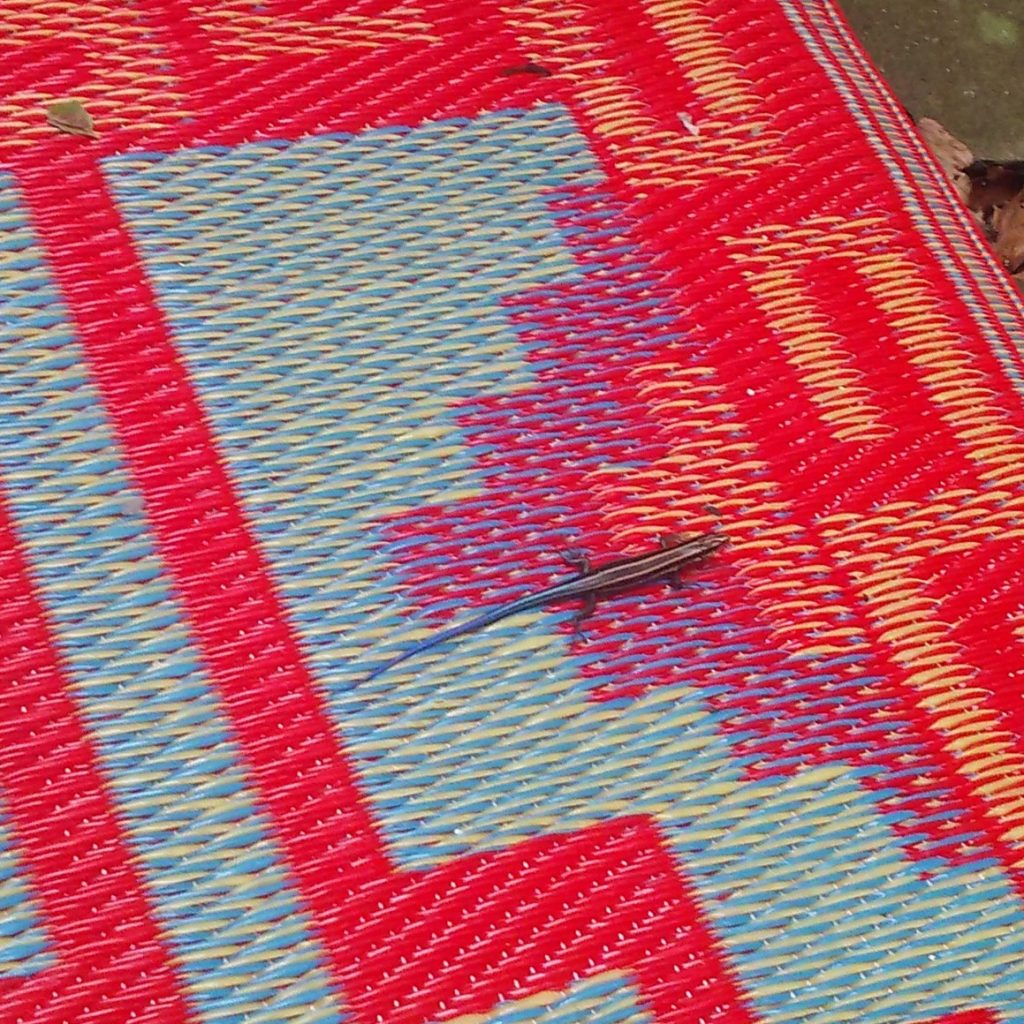
The only frequent visitors who managed to escape the camera entirely were the dragonflies. The ones we saw must have been females; they didn’t have the male’s chunky white tails but they had the checkered wings denoting a Common Whitetail (Plathemis lydia). All summer long, they landed on the rocks and plants in our garden, on our sidewalk, on our flip-flops, and on various body parts. But we could never produce the camera in time. Or getting out the camera made them fly away. But that’s life, isn’t it? Our closest encounters are often the most fleeting. Although we can’t produce any proof that they happened at all, we know that they did because they open our frightened hearts, allowing hope to crawl inside and burrow down deeply enough to find the warmth to breathe and stay alive.
[1] Now we’re thinking now that, due to his bumpy skin and his love of getting into holes in the ground, Kermit may have actually been an Eastern American toad (Anaxyrus americanus). https://thefroglady.wordpress.com/2019/03/07/frogs-of-maryland/
[2] For more on how frogs and toads survive winter, see https://www.scientificamerican.com/article/how-do-frogs-survive-wint/
[3] If you want to attract frogs and toads to your garden, see https://dengarden.com/gardening/Attracting-Frogs-and-Toads-To-Your-Garden
[4] Ifyou want to attract Tiger Swallowtails, see https://butterflywebsite.com/articles/tiger-swallowtails.cfm
[5] Formusings on the meaning of when a butterfly lands on you, see https://www.thelist.com/166664/what-does-it-mean-when-a-butterfly-lands-on-you/#:~:text=%22A%20butterfly%20landing%20on%20you,be%20trusted%20with%20delicate%20things.%22
[6] Here’s a fascinating video about Katydids. https://www.youtube.com/watch?v=MdMMUoKRBSk.
[7] This family tells about the katydid they named Bartholomew, whom they found living in their house and decided to feed and keep as a pet because they were so enthralled with him. https://www.csmonitor.com/2000/0927/p22s1.html. WikiHow tells you how to keep a katydid as a pet. https://www.wikihow.com/Take-Care-of-a-Katydid-Insect
[8] For more details about these bashful insects, see https://www.thoughtco.com/leaf-footed-bugs-family-coreidae-1968621
[9] Formore info on the kinky skink, see https://www.chesapeakebay.net/discover/field-guide/entry/five_lined_skink
